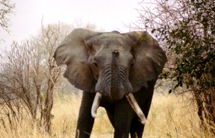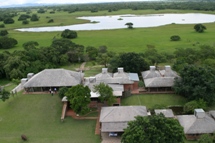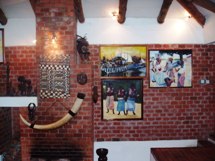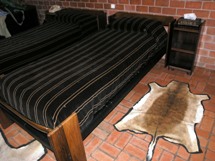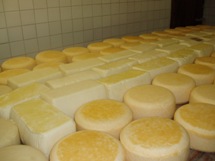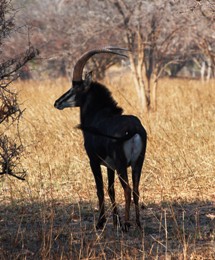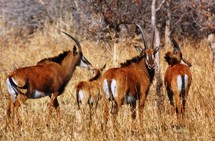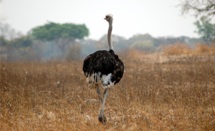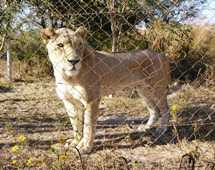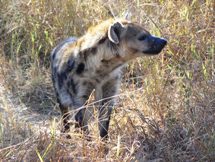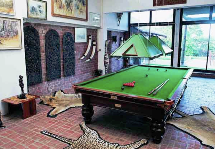Zambia (1): Day Twentytwo : Flatdogs Camp to Chaminuka Lodge
The following morning we said our goodbyes to Flatdogs, hugely pleased to have visited them, and promising to include them strongly in our future marketing. Our flight back to the UK was scheduled for very early the following morning, necessitating an overnight stay in Lusaka. Normally having to overnight in an African capital city is not the world’s finest experience, especially after several weeks out in the bush, but Zambia is the exception to this, since it is possible to stay in a privately owned game reserve - Chaminuka Lodge - just on the city’s outskirts, which rivals most other places stayed in.
Thus we headed back to Mfuwe airport, incorporating a brief game drive into the transfer. There was still a moment of excitement to be experienced when we met a bull elephant blocking our route. Rather than turning and heading back into the bush, it backed in instead, thus still facing our route, and looking quite capable of charging us if we attempted to drive past (![]() ). Our driver instead took us on a long sweep into the bush, and we roared off untouched.
). Our driver instead took us on a long sweep into the bush, and we roared off untouched.
On the road into Mfuwe we called into a local textiles shop where we were able to watch how traditional Zambian textile designs were created using local labour. You might have thought that the shop prices themselves would reflect the local nature of the business, but they were actually at the level you might expect in an upmarket New York store, and we decided to forgo the opportunity.
On arrival in Lusaka we drove straight out to Chaminuka (![]() ), arriving in time for lunch. Here the choice included puku, warthog and kudu, and the comment was made that if there was any game that we hadn’t seen we at least stood a chance of eating it here. Chaminuka was originally a cattle farm, since developed into a private game reserve by the Sardanis family, and incidentally also housing Zambia’s biggest private art collection, with innovative sculptures jostling with striking modern art canvasses, all created by local Zambian artists (
), arriving in time for lunch. Here the choice included puku, warthog and kudu, and the comment was made that if there was any game that we hadn’t seen we at least stood a chance of eating it here. Chaminuka was originally a cattle farm, since developed into a private game reserve by the Sardanis family, and incidentally also housing Zambia’s biggest private art collection, with innovative sculptures jostling with striking modern art canvasses, all created by local Zambian artists (![]() ).
).
Chaminuka actually hosts quite a bit of hunting within its grounds (the walls of the communal bar area used to be jammed full of trophy heads, which some guests felt uncomfortable with, and these have now gone, although animal skins continue to serve instead of carpeting on your room floor (![]() ). Actually there is quite a lot of hunting in Zambia – within the ‘Game Management’ Areas (GMAs) outside the National Parks, although it is very difficult to get your camp hosts to discuss this in any way at all.
). Actually there is quite a lot of hunting in Zambia – within the ‘Game Management’ Areas (GMAs) outside the National Parks, although it is very difficult to get your camp hosts to discuss this in any way at all.
Although we had a game drive planned within Chaminuka’s extensive grounds later that afternoon, our first excursion was to its on-site cheese factory (![]() ). This might sound a strange outing to take (except to the gentleman discussed in Day One’s ‘Camp Fire Tale’), but was actually extremely fascinating. Unfortunately ‘Health & Safety’ regulations, or whatever passes for these locally, have ended this opportunity.
). This might sound a strange outing to take (except to the gentleman discussed in Day One’s ‘Camp Fire Tale’), but was actually extremely fascinating. Unfortunately ‘Health & Safety’ regulations, or whatever passes for these locally, have ended this opportunity.
Although lacking the adrenalin rush of the true bush, Chaminuka’s private game reserve well repays exploration, since, being a private, enclosed, game reserve, Chaminuka can choose what it stocks, and we added blue wildebeest, sable (![]() ), roan (
), roan (![]() ), and tsessebe and ostrich (
), and tsessebe and ostrich (![]() ) to our ‘sightings’ list, in addition to further elephant, eland and zebra. There were also numerous buffalo, each one unexpectedly bearing a number on its rump. There are also a couple of fenced enclosures housing lions (
) to our ‘sightings’ list, in addition to further elephant, eland and zebra. There were also numerous buffalo, each one unexpectedly bearing a number on its rump. There are also a couple of fenced enclosures housing lions (![]() ) and hyena (
) and hyena (![]() ), which in some ways is rather sad, although they aren’t individuals who could ever be released into the wild. At least it provides the opportunity to see these fascinating creatures at very close range.
), which in some ways is rather sad, although they aren’t individuals who could ever be released into the wild. At least it provides the opportunity to see these fascinating creatures at very close range.
In the evening, following our first hot baths after nearly two weeks of taking showers, we enjoyed probably our best meal yet – truly Chaminuka is a place not to miss. After the meal we played a couple of frames of snooker in a bizarre setting characterised by several large cat skins, with still-intact heads, serving as floor rugs (![]() ), although trying to set up one’s shot while balancing on a lion’s head was quite bizarre.
), although trying to set up one’s shot while balancing on a lion’s head was quite bizarre.
![]()
On one previous trip we were staying at Robin Pope’s Nkwali camp, prior to setting off on a walking mobile safari in just about the most remote region of the valley. The night before we set out we were taken to one side and told that New York’s World Trade Centre had apparently just been destroyed by a suicide aircraft attack, but this was all that was known. The next morning we set off into the wilderness, aware that there could well have been 50,000 or more people killed, and that, for all we knew, London could have been the following day’s target.
For a parent, far from one’s family, this was a very unsettling experience. Indeed, while most of the world went through the intense emotion of the incident and its aftermath live on TV, we were totally isolated from this, and could only experience it at second hand a week or so later – hence never really suffering the trauma felt by most of the rest of the world.
Although we did have a satellite radio with us on the walk, it could only be persuaded to function intermittently. On one occasion we picked up a Polish news station (broadcasting in English), but all that it had to say in terms of ‘hard’ news, was that apparently no Poles had been killed in the incident. We did pick up one other English-language station, after much fiddling, only to hear that they were now going to have ten minutes silence for the dead, by which time we had gone off signal again.
It seems bizarre to relate now, but the immediacy of seeing a kudu being taken down and killed by a pride of lions seemed to be what was real, rather than what was happening in America. Indeed an indication of how remote the happenings in the Western world can appear in the heart of the African bush, is given by the fact that many of the Zambians that we have met since have never even seen images of the disaster, nor do they really understand what was involved.
| Back to previous page (Day 21) | Forward to next page (Day 23) |
